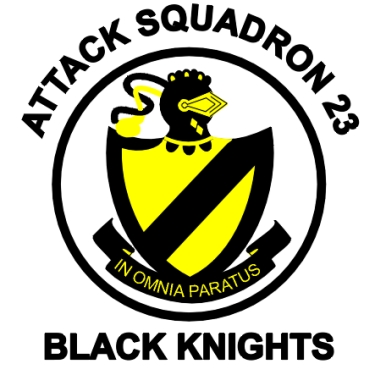


VA-23 was established as a reserve fighter squadron just after WWII and, over the next twenty years, accumulated an impressive service record that included combat in two wars and several notable firsts, including the first combat use of a Shrike ARM. The Black Knights operated thirteen variants of six aircraft, including F4Us and A-4Fs, before their disestablishment in April of 1970. The squadron held a reunion in November, 1994, at Naval Air Station Pensacola.
Insignia
The squadron's first insignia was approved by CNO on 07 February 1951. The central figure is the dragon, symbolizing the terrifying qualities representative of a fighter squadron, and the shield portraying its strength. Insignia colors were: yellow outer border; blue background; red dragon with yellow shaded areas and black markings; light blue shield with diamond and checkered bar in yellow.
When the squadron was redesignated VF-151, it adopted a new insignia sometime between 1953 and 1955. This insignia was a shield with a knight's helmet at the top and a banner at the bottom with the Latin inscription "In Omnia Paratus" translated as "Always Prepared." Colors were: white background with black outer circle; black helmet, banner, outer border of shield and diagonal bar ascending from left to right across the shield; helmet visor was yellow with black markings; the two central portions of the shield and Latin motto were yellow; two plumes trailing from the helmet were one yellow and one black. There is no record relating to the use of this insignia following the squadron's redesignation to VA-151. However, on 29 April 1959, CNO approved VA-23's request to retain the insignia formerly used by VA-151. The insignia used by VA-23 was the same Black Knight design.
Lineage
December, 1949. Established as Reserve Fighter Squadron SIX HUNDRED FIFTY THREE (VF-653) based at NAS Akron, Ohio.
February 1, 1951. Called to active duty.
February 4, 1953. Redesignated Fighter Squadron ONE HUNDRED FIFTY ONE (VF-151)
February 7, 1956. Redesignated Attack Squadron ONE HUNDRED FIFTY ONE (VA-151)
February 23, 1959. Redesignated Attack Squadron TWENTY THREE (VA-23)
April 1, 1970. Disestablished. The first and only squadron to be designated VA-23.
Chronology of Significant Events
December 11, 1951. The squadron conducted its first combat strikes.
February, 1955. Deployed aboard Wasp (CVA-18) the squadron provided air support during the evacuation of Chinese Nationalists from the Tachen Islands following the bombardment of the islands by the People's Republic of China.
April, 1965. While operating from Midway (CVA-41) on Yankee Station VA-23 conducted its first combat operations since the Korean War.
April, 1965. VA-23 became the first squadron to use the Shrike anti-radiation (radar) missile in combat.
15-20 March 1968. VA-23 and other CVW-19 squadrons conducted flight operations from Ticonderoga (CVA-14) in the Sea of Japan as part of Operation Formation Star. This show of American forces was in response to the capture of Pueblo (AGER-2) by North Korea on 23 January 1968.
April 1968. VA-23 flew combat strikes around Khe Sanh, South Viet Nam in support of the besieged Marine base.
20 March 1970. A disestablishment ceremony was held by the squadron under the direction of its last commanding officer, CDR Theodore L. Lloyd, Jr. CDR Lloyd accepted the colors of the squadron and brought to a close over 19 years of distinguished active service. The squadron was officially disestablished on 1 April 1970.